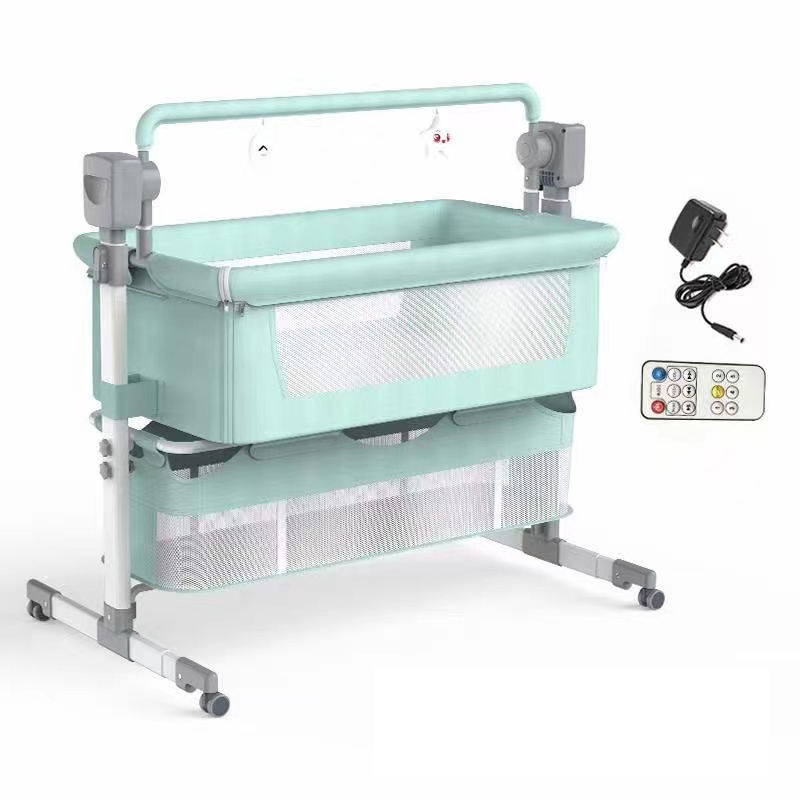A baby crib, often simply referred to as a crib, is a specialized bed designed for infants and young children. It provides a safe and enclosed space for babies to sleep and rest.
Cribs are a central piece of furniture in a nursery, providing a dedicated and secure sleeping space for infants. They play a crucial role in creating a safe and comfortable environment for babies to rest and sleep. When using a crib, it's essential to follow safety guidelines, regularly inspect the crib for any signs of wear or damage, and ensure that the mattress and bedding meet safety standards.
Enclosed Design: Cribs have high sides to prevent the baby from rolling out or accidentally falling during sleep. This enclosed design promotes a secure sleeping environment.
Slatted Sides: The sides of the custom baby crib are often constructed with slats to allow for proper air circulation and visibility. This ensures that parents can easily check on the baby while they are in the crib.
Adjustable Mattress Heights: Many cribs come with an adjustable mattress support system that allows the mattress to be positioned at different heights. This feature is particularly useful as the baby grows and becomes more mobile.
Convertible Options: Some cribs are designed to convert into different bed configurations as the child grows. This may include converting into a toddler bed, daybed, or even a full-sized bed, providing long-term utility.
Safe Materials: Cribs are typically made from sturdy and safe materials, ensuring durability and adherence to safety standards. Non-toxic finishes are commonly used to protect the baby from harmful chemicals.
Regulatory Standards: Baby cribs are subject to safety regulations and standards to ensure they meet certain criteria for construction and design. It's important for parents to choose cribs that comply with these safety standards.
Safe Sleep Practices: Using a crib encourages safe sleep practices recommended by health professionals, such as placing the baby on their back to sleep and avoiding soft bedding.
Enclosed Design: Cribs have high sides to prevent the baby from rolling out or accidentally falling during sleep. This enclosed design promotes a secure sleeping environment.
Slatted Sides: The sides of the crib are often constructed with slats to allow for proper air circulation and visibility. This ensures that parents can easily check on the baby while they are in the crib.
Adjustable Mattress Heights: Many cribs come with an adjustable mattress support system that allows the mattress to be positioned at different heights. This feature is particularly useful as the baby grows and becomes more mobile.
Convertible Options: Some cribs are designed to convert into different bed configurations as the child grows. This may include converting into a toddler bed, daybed, or even a full-sized bed, providing long-term utility.
Safe Materials: Cribs are typically made from sturdy and safe materials, ensuring durability and adherence to safety standards. Non-toxic finishes are commonly used to protect the baby from harmful chemicals.
Regulatory Standards: Baby cribs are subject to safety regulations and standards to ensure they meet certain criteria for construction and design. It's important for parents to choose cribs that comply with these safety standards.
Safe Sleep Practices: Using a crib encourages safe sleep practices recommended by health professionals, such as placing the baby on their back to sleep and avoiding soft bedding.

Ensuring the safety of an infant bedside crib is paramount for creating a secure sleep environment for infants. Here are key guidelines for baby crib safety:
Firm Mattress:
Use a firm and flat mattress that fits snugly into the crib. Ensure there are no gaps between the mattress and the crib walls to prevent the baby from getting trapped.
No Soft Bedding:
Avoid placing soft bedding, such as pillows, quilts, and bumper pads, in the crib. These items pose a suffocation risk and are not recommended for the baby's sleep environment.
Positioning:
Always place the baby on their back to sleep. This reduces the risk of Sudden Infant Death Syndrome (SIDS). Avoid placing the baby on their side or stomach for sleep.
Crib Placement:
Position the crib away from windows, curtains, blinds, and cords to prevent the baby from reaching or getting entangled in them. Also, avoid placing the crib near radiators or heating vents.
Sturdy Construction:
Ensure the crib is sturdy and well-constructed. Regularly check for loose or missing hardware, cracked wood, or any signs of wear. Discontinue use if there are safety concerns.
Adjustable Mattress Heights:
If the bed side sleeper crib has adjustable mattress heights, use the higher positions for newborns and lower it as the baby becomes more mobile. This prevents the baby from climbing out.
Avoid Overcrowding:
Keep the crib free from toys, stuffed animals, and loose blankets. These items can pose a suffocation risk. If needed, use a sleep sack or wearable blanket for added warmth.
Safe Paint and Finishes:
Ensure that the crib's paint and finishes are non-toxic and meet safety standards. Check for any chipping or peeling paint and address it promptly.
Follow the Manufacturer's Guidelines:
Adhere to the manufacturer's guidelines for assembly, use, and weight limits. Follow any specific instructions for convertible cribs if transitioning to different bed configurations.
Regular Inspections:
Regularly inspect the crib for safety. Check for any recalls related to the crib model and address any issues promptly.
Avoid Drop-Side Cribs:
Avoid using drop-side cribs, as they have been associated with safety issues. Choose cribs with fixed sides to ensure stability.
Safe Distance Between Slats:
The distance between crib slats should be no more than 2.375 inches (about the width of a soda can) to prevent the baby's head from getting stuck.
By following these safety guidelines, parents can create a secure sleeping environment in the crib and promote the well-being of their baby during sleep. Always stay informed about current safety standards and recommendations from health professionals.